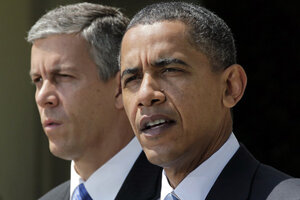Poll: Americans' grade for Obama education policy is slipping
Just 34 percent of Americans give the president an A or B, compared with 45 percent a year ago, a new survey on education says. But the poll also shows more nuanced views of education policy.

President Barack Obama, accompanied by Education Secretary Education Arne Duncan, speaks in the Rose Garden of the White House in Washington, on Aug. 10.
J. Scott Applewhite/AP
Americans’ support for President Obama’s education agenda is slipping, a new poll indicates.
Just 34 percent of Americans give the president a grade of A or B in his support of public schools, compared with 45 percent a year ago, according to the survey of public opinion on education, conducted by Phi Delta Kappa International (PDK) and Gallup. Support was down among Democrats and independents as well as Republicans.
But the survey, released Wednesday, also shows a more nuanced view of how the public views America’s schools and education policy. Support is growing for ideas like charter schools and merit pay for teachers, which are being pushed by the administration. But support is slim for the sort of drastic school-turnaround strategies sometimes favored by Education Secretary Arne Duncan. When asked about the best way to deal with a poorly performing school in their community, more than half of respondents said that the school should remain open with the existing staff and get more support.
“If I were working at the [Education] Department, I would seriously rethink [the turnaround strategy],” says William Bushaw, executive director of PDK, referring to the department’s support of plans in which the principal and much of the staff at a failing school is fired. “Americans just don’t want Washington to get that far into their local affairs.”
Controversial policies like merit pay, on the other hand, are getting considerably more support from the public, with 71 percent of Americans saying that teachers should be paid based on the quality of their work rather than on a standard scale. Almost 3 in 4 believe that teacher pay should be at least somewhat tied to student achievement.
“I think we all need to recognize that the current system by which we pay teachers is broken,” Mr. Bushaw says.
The poll also revealed a growing consensus that teaching is what matters most in a school, as well as a broad respect for the profession.
By a wide margin, respondents said the most important national education priority is to improve the quality of teachers, ahead of developing better standards, turning around the lowest-performing schools, and creating better tests.
“That’s right on track with the research that shows that the No. 1 thing that impacts student achievement is the quality of a student’s teacher,” says Jon Schnur, co-founder and CEO of New Leaders for New Schools, which is based in New York.
But the poll, Mr. Schnur notes, shows a broad discrepancy in terms of how Americans view their local school versus how they view the nation’s schools. Nearly half of respondents gave the schools in their community an A or B, and 77 percent gave that grade to the school their oldest child attends. When asked to rate the nation’s schools, just 18 percent gave them an A or B.
“While the American public is totally right about respecting the teacher and improving the quality of teaching, I think the American public is wrong about the quality of their community’s schools,” Schnur says. “This overestimate of the quality of local schools makes people less inclined to support dramatic interventions.” He sees a lack of good data available as a factor in Americans’ perceptions.
On the other hand, says Dan Domenech, executive director of the American Association of School Administrators, the poll results should serve as a signal to administration officials that some of their policies – particularly when they support getting rid of staff – are out of line with what the public wants. “They have to keep in mind that this is a local effort,” he says.
In an open-ended question, poll respondents chose school funding as the biggest challenge for schools right now. It’s an answer that has been consistent throughout this decade but is a change from past decades, when problems like discipline and drugs were at the top of the list. For the first time, the problem of too much government intrusion made its way to the top of the list, moving from 15th place in last year’s poll to fifth place this year.
The drop in ratings for Mr. Obama’s education agenda mirrors a drop in his overall approval ratings, which have gone from 52 percent last year to just 44 percent now, notes Shane Lopez, a senior scientist at Gallup and co-director of the poll.
One factor that may not help Obama’s cause is that so few Americans seem to have felt the impact of the $100 billion in stimulus funds for US schools. Just 20 percent of respondents said they were aware of stimulus money going to their school.
“Any road project or building project you see [paid for with stimulus money], there’s a very clear sign,” says Bushaw. “There were no signs like that for funding going to education, unfortunately.”
